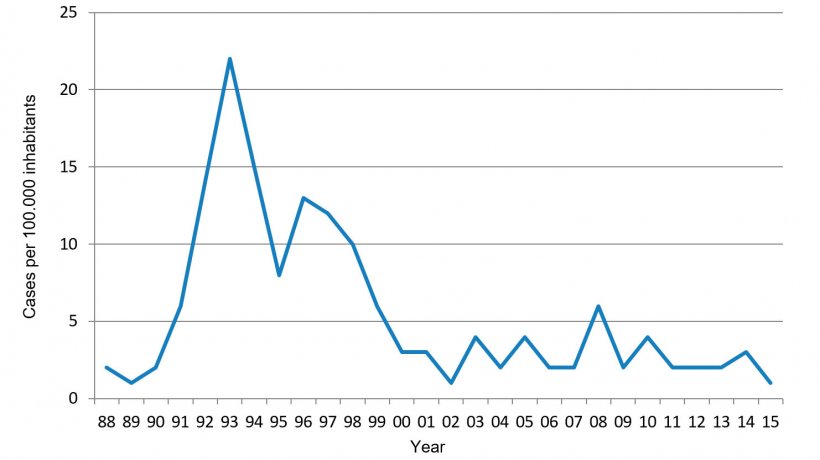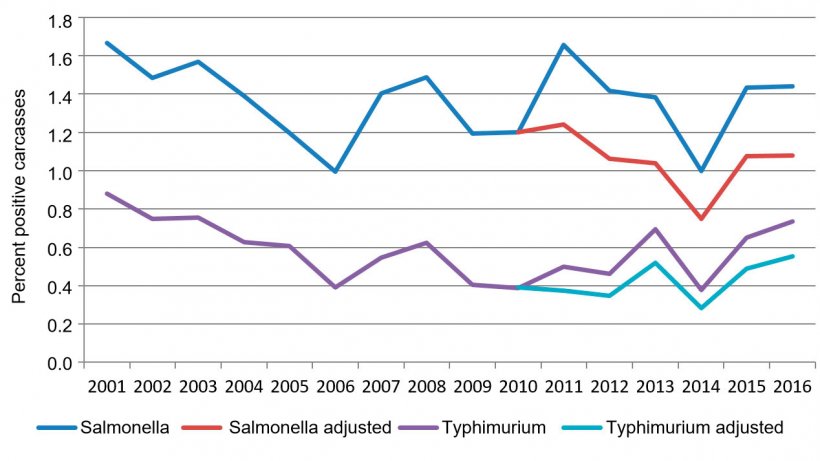Twenty-four years after the beginning of the Danish salmonella program, the number of human cases caused by Danish produced pork has been reduced by more than 95 % (Annual Report 2015, the Danish Zoonosis Centre).


Many things have changed, new insights have been incorporated, and surveillance systems have been optimized.
Today it is clear, that although there is an association between the level of salmonella in the herd of origin and carcass prevalence, as shown in several studies, it is also clear, that the association is not proportional. Even relatively large increases in prevalence in primary production can be mitigated by improved hygiene in the slaughterhouses.
Several studies from 1998 to 2016 showed that there was an increase in bacteriologically positive finishers from 1998 to 2010, although methodological differences in the studies make it difficult to make direct comparisons. From 2010 the prevalence in primary production has stabilized.
From 1993, when the program started until 2000, salmonella surveillance in slaughterhouses was based on microbiological samples from many different cuts. Sampling was not sufficiently standardised to evaluate whether salmonella in pork increased or decreased.
From 2001, microbiological surveillance was changed into a standardised procedure, where 3 specific areas where swapped on the carcass, covering an area of 300 cm2.
From 2001 to 2010 carcass prevalence dropped from 1.7 to between 1 and 1.2 %. In 2011 carcass surveillance was changed from being based on a pooled sample of 3 times 100 cm2 to 4 times 100 cm2. This increased the observed carcass prevalence to 1.7 %, which is close to what would be expected, if it is assumed, that the increase of surface area would result in a similar increase in sensitivity. Since 2011, carcass prevalence has fallen to between 1 and 1.4 %.
In the same period serotype-distribution has shifted from Salmonella Typhimurium to S. Derby. In 2001 18 % of positive carcass swabs were Derby. In the last 5 years, Derby has accounted for more than 35 % of the positive carcasses. Typhimurium has dropped from 0.9 % to between 0.3 and 0.5 %. Figure 2 shows the carcass prevalence, including a sensitivity correction for the change in surveillance in 2011, to be able to compare before and after the change.

Primary production
The observed increase in bacteriologically and serologically positive pigs in the beginning of the century initiated several epidemiological studies into understanding why. Despite severe penalties imposed on herds with high salmonella prevalence, deducting up to 8 % of the carcass value, the level had increased.
The epidemiological studies showed that although the proportion of high prevalence herds had not increased dramatically, more herds now have a low to moderate level, indicating ongoing spread of salmonella to more herds over the years.
Gilt-producing herds and sow herds were shown to be very important for the spread of salmonella to finisher herds. When the program started, it was generally believed, that gilt-producing herds and sow herds with a high level of salmonella would be a higher risk for the finisher herd than gilt-producing herds and sow herds with a low level. But the epidemiological studies showed that gilt-producing herds and sow herds that were positive for Salmonella typhimurium were a risk for the finisher herds, no matter whether the prevalence was moderate or high.
Based on these results, the Danish pig production and the Veterinary and Food Administration initiated a new declaration system. Gilt-producing herds and sow herds now have a salmonella status, which is publicly available in the official Zoonosis Register. The pig industry manages a home page with open health declaration of all Danish pig herds (www.spf-sus.dk), and the information includes salmonella status.

The increase in salmonella prevalence in pig herds has been observed in several countries who have initiated similar surveillance programmes in finisher herds, based on meat-juice samples or blood samples. Probably this reflects that it is necessary to implement surveillance on gilt producers and sow herds, if a control program in primary production is to be successful.
The future
The success of the Danish salmonella program in pigs and pork is a result of improvements in slaughterhouse hygiene, more than it can be attributed to control in primary production.
Today focus is on the end result, measured as carcass prevalence. The target of the Danish pig and pork industry for the coming years is to keep carcass prevalence at or below 1 %. A strong focus on slaughterhouse hygiene, follow up on all results that does not live up to the standards, and good collaboration and commitment from all involved, authorities, pig producers and slaughterhouses are key to achieving good results.




